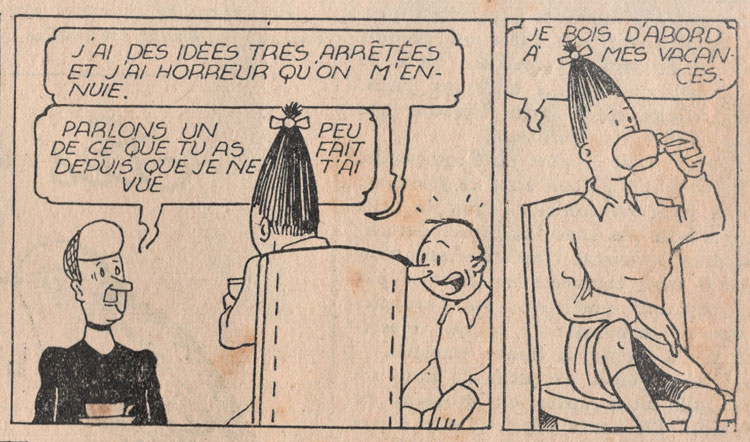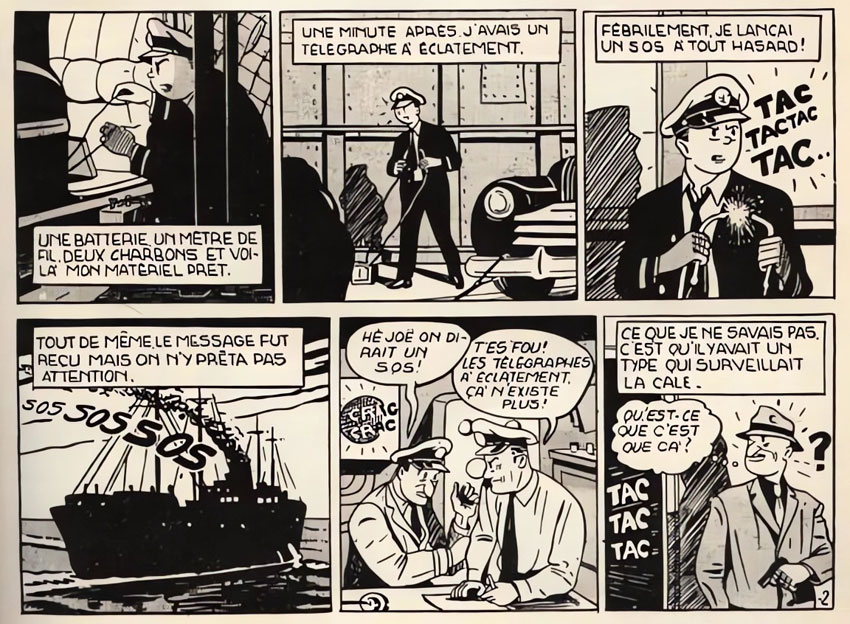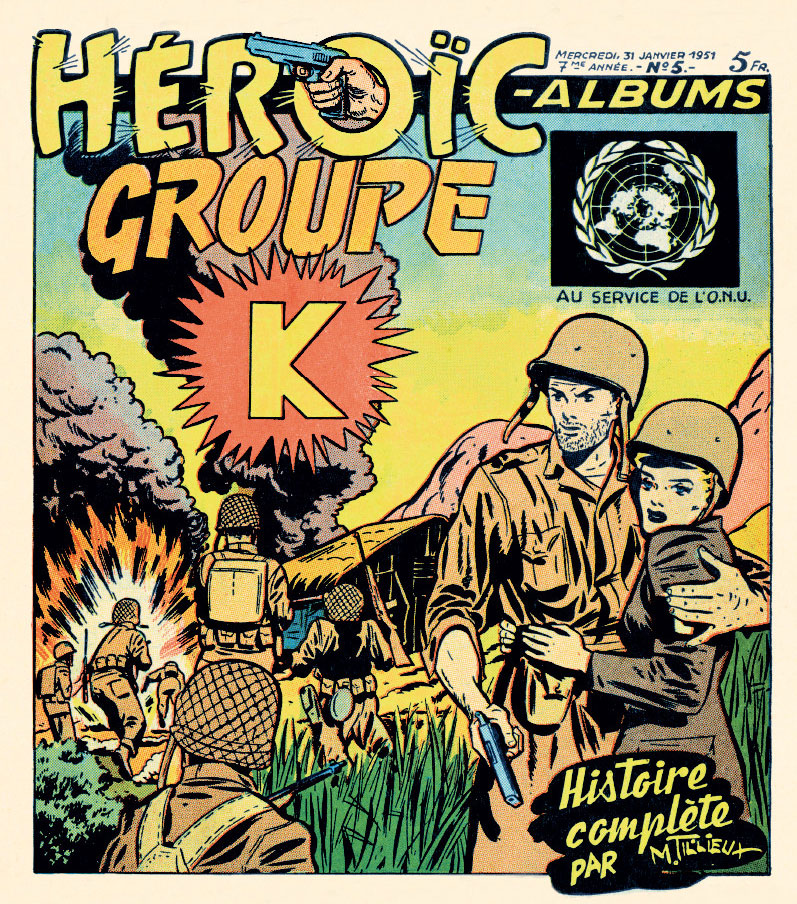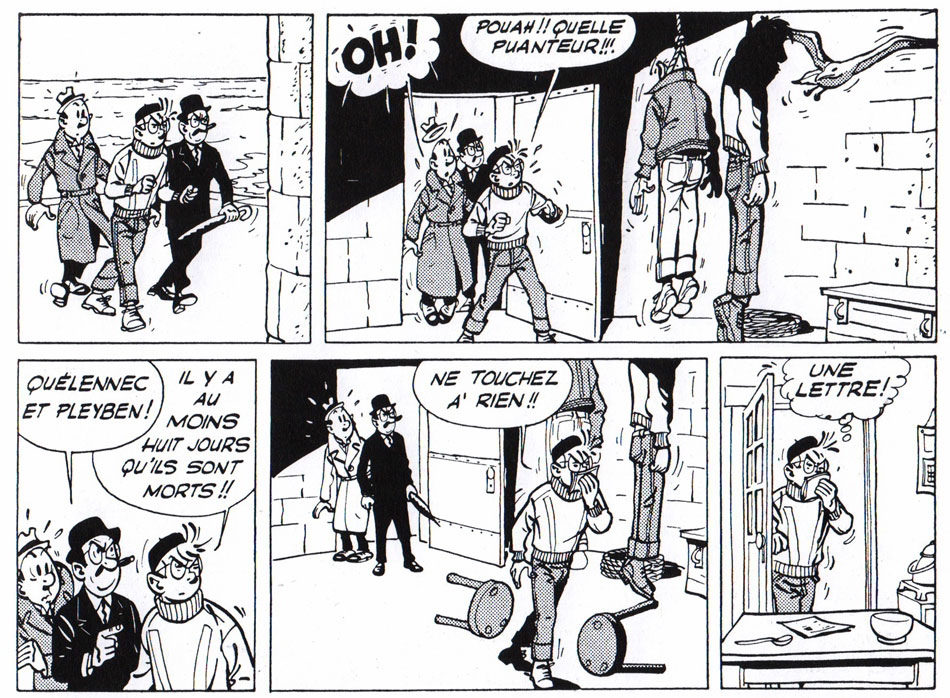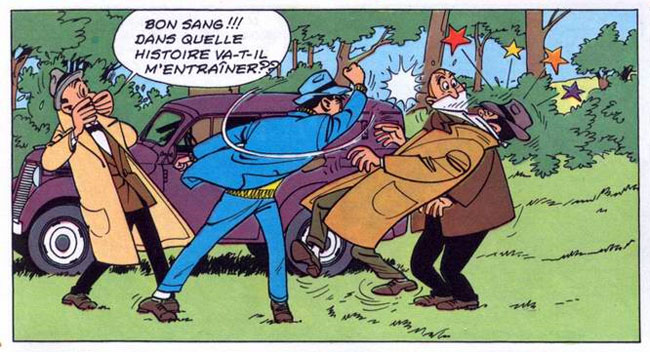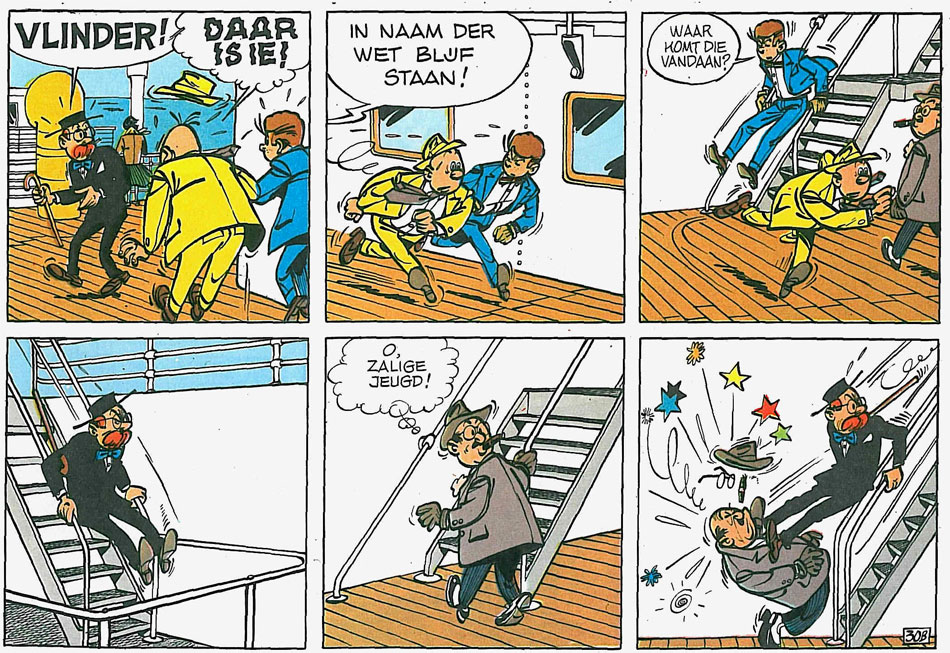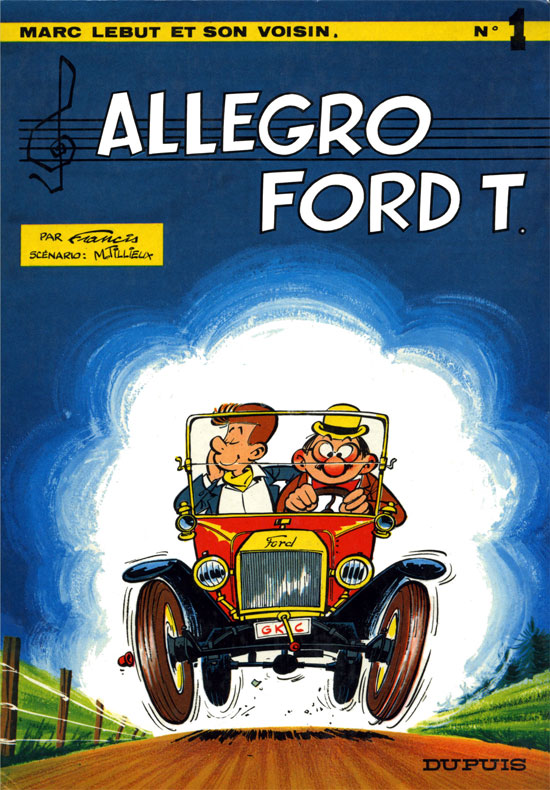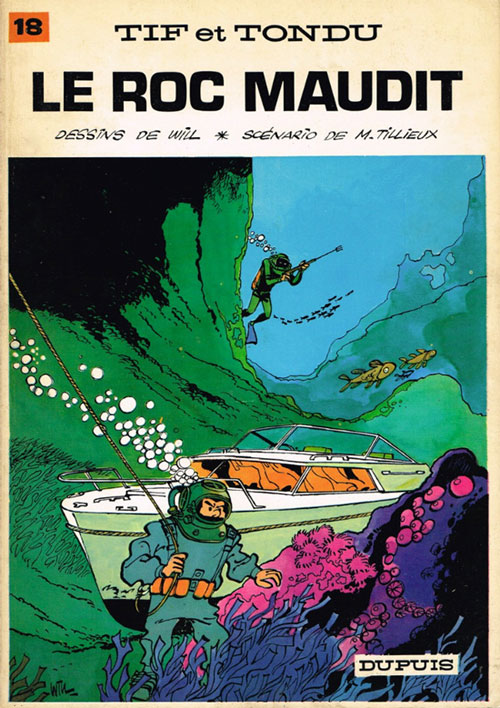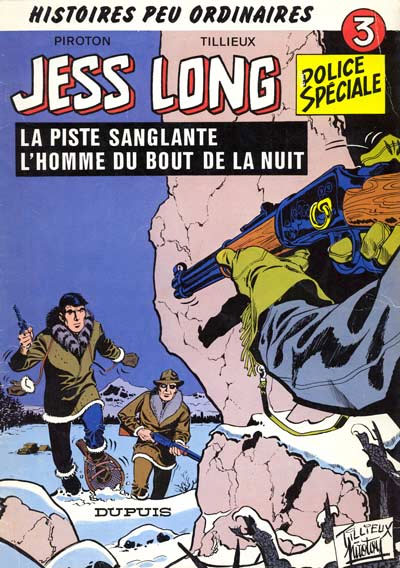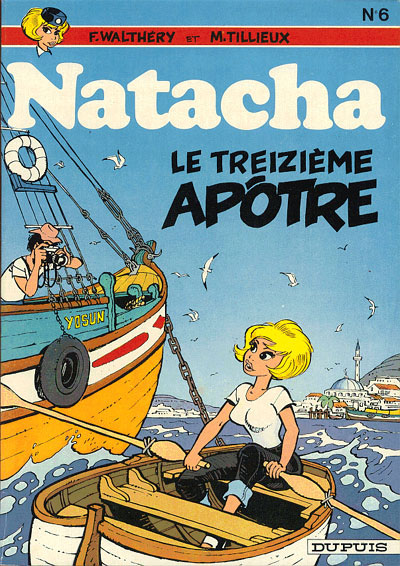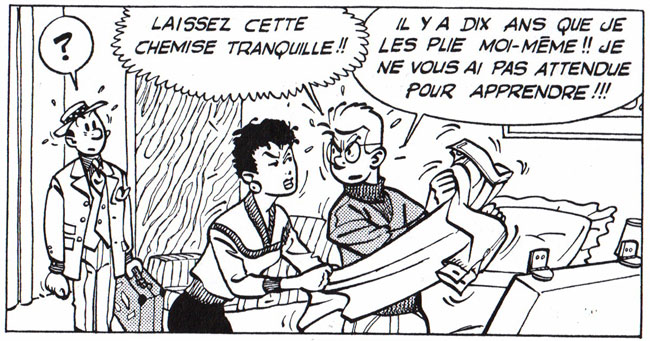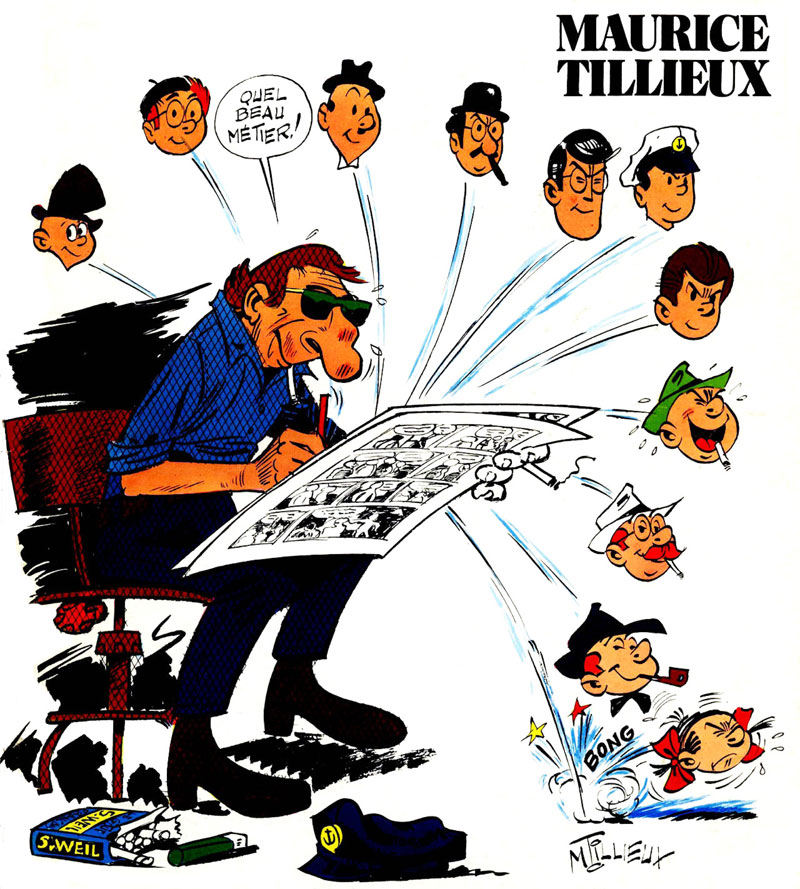Gil Jourdan - 'La Voiture Immergée' (1958).
The Belgian comic creator Maurice Tillieux was a master of the detective story, and his signature creations 'Félix' (1949-1956) and 'Gil Jourdan' (1955-1978) set the standard for many other series in the genre. A staple of Fernand Cheneval's Héroïc-Albums and then Spirou magazine, his work is renowned for its well-conceived plots, multi-dimensional characters and moody artwork. Like no other, Tillieux could create atmosphere and excitement through his skilful depictions of dilapidated neighborhoods, rainy harbor scenes and cinematic car crashes. Unlike most other European youth comics of the time, his series had mature heroes with realistic character traits. His snappy dialogues didn't sound childish, but instead revealed edgy protagonists with whims and flaws. In suspense scenes, he hardly used any dialogue at all, leaving all the power to the visual storytelling. In addition to adventure comics, Maurice Tillieux also tried his hand at gags through the domestic tribulations of the unlucky comic artist 'César' (1959-1966), published in Le Moustique magazine. From the mid-1960s until his untimely death in 1978, Maurice Tillieux was Spirou magazine's main comic scriptwriter, working with artists like Will ('Tif et Tondu'), Roger Leloup ('Yoko Tsuno'), Francis ('Marc Lebut et son Voisin'), François Walthéry ('Natacha'), Jean Roba ('La Ribambelle') and Arthur Piroton (‘Jess Long’). While he never enjoyed the same kind of international fame as some of his colleagues, Tillieux's work has proven to be remarkably timeless, as it is still rediscovered by new generations and remains a strong influence on many contemporary European comic artists.
Early years
Maurice Jules Alexandre Florent Tillieux was born in 1921 in Huy, a town in the province of Liège. He was the only child of French parents; his father was a stationmaster and his mother a school teacher. In 1935, the family relocated to one of the suburbs of Brussels. As a child, Maurice enjoyed reading the comic magazines of publisher Offenstadt - Cri-Cri, Le Petit Illustré and L'Épatant - but he grew particularly fond of detective literature. Among his favorite authors were Agatha Christie, Arthur Conan Doyle and Ellery Queen, but he also devoured the 'Harry Dickson' stories of Jean Ray and the 'Arsène Lupin' books by Maurice Leblanc. Later on, he also developed a passion for American cinema, most notably Humphrey Bogart classics like 'Casablanca' (1942) and 'The Maltese Falcon' (1941). Elements of film noir can be seen in Tillieux's cinematographic approach of action sequences, and in his atmospheric use of black-and-white. His main graphic influences were Hergé, Jijé, André Franquin, Peyo, Martin Branner and Milton Caniff. Another influence on Tillieux's artwork are the chiaroscuro paintings by Belgian surrealist painter Paul Delvaux, who also had a fondness for streets lit by gas lamps, foggy nights, heavy rain, and abandoned places.
One of his high school friends was the son of Jean-Georges Evrard, who, under the pen name Jean Doisy, became the first editor of the comic magazine Spirou, published by Dupuis. As Maurice Tillieux frequented the Evrard household, he witnessed first-hand how in 1938 the legendary Belgian comic magazine saw the light. Jean Doisy also offered him his first illustration jobs. Already in 1937, sixteen-year old Maurice Tillieux had his first drawing published in Le Moustique, another Dupuis magazine. Until 1941, he regularly provided illustrations to both Le Moustique and Spirou, in the latter particularly for the 'Fureteur' and 'Fantasio' columns by Jean Doisy..
However, illustrating was not Maurice Tillieux's initial call, as he wanted to sail the seas. Together with a friend, he took navigation courses in Ostend and then joined the merchant marines. However, his plans came to a sudden halt, when the Germans invaded Belgium and the Belgian navy became inactive. Tillieux enjoyed telling the story how he and his fellow students were standing in the Bordeaux harbor, when a German Stuka plane bombed one of the ships, forcing the boat that was just coming to pick up the young sailors to instantly turn around, and thus ending their naval careers altogether. Although the outbreak of World War II forced Maurice Tillieux to make new career plans, shady and misty harbors continued to appear frequently in many of his comic stories.
Early career
For most of the World War II years, Maurice Tillieux was in hiding to avoid forced labor. He earned some money by writing detective novels for the collection Le Sphinx of the Liège-based publisher Éditions Maréchal. His first book was 'Le Navire Qui Tue Ses Capitaines' ("The Ship That Killed Its Captains", 1942). Under the pen name John Holderson, he wrote a second novel, 'L'Homme Qui S'Assassina' ("The Man Who Killed Himself"), but it is unknown if this book was actually released. During this period, Tillieux additionally painted advertisements for store fronts and made illustrations for French and Belgian magazines. In 1942, Tillieux also drew his first comics, which remained unpublished. After the liberation of Brussels in September 1944, the Dupuis magazines Le Moustique and Spirou reappeared on the market, again containing the occasional Tillieux illustration. However, these assignments did not result in a steady income, so Tillieux tried to find his luck elsewhere.
'Zénobie'.
Studio Guy
By advice of Spirou editor Jean Doisy, Tillieux applied for a job with Studio Guy, a Brussels art studio run by Guy Depière, that was just entering the children's magazine market with the launch of Bimbo magazine. After starting as the studio's archivist in the Fall of 1944, Tillieux turned to creating comic stories when Depière needed content for his newly launched title, Jeep. By June 1945, the self-taught artist Maurice Tillieux provided nearly all of the comic art for both Bimbo and Jeep. To boost up sales, publisher and story writer Depière had him use a whole range of anglicized pseudonyms, such as John Cliff, James Jhames, Ronald Scott and Jill Morrison.
Among the many comic features drawn by Tillieux during this period were 'Bimbo, Romarin et Misky', 'Les Nouvelles Aventures de Bricole', 'La Bande Infernale', 'Les Débrouillards', 'Jonas et Zénobie', 'Zouzour et Zourzou' and 'Les Deux Obscurs'. Aiming at quantity instead of quality, the overambitious publisher Depière launched an additional magazine for girls in 1946, Blondine. The Studio Guy team was expanded with artists like Fernand Cheneval, Marcel Moniquet and Fred Funcken, but Guy Depière's dreams quickly shattered. Failing to compete with popular Belgian comic magazines like Tintin and Spirou, by early 1949 all of the Depière magazines were off the market.
Zénobie
While many early comics by Tillieux are now forgotten, 'Zénobie' later caught the attention of comic historians. The title character of the series is an egg-headed young girl, wearing a white dress. She works as an assistant-detective and, to modern-day readers, looks exactly like Wiske from Willy Vandersteen's comic series 'Suske en Wiske'. Since Tillieux became Vandersteen's assistant later in the 1940s, speculation has risen whether Vandersteen copied Zénobie's design, or the other way around. However, 'Zénobie' debuted in Jeep in late 1945, while Vandersteen had already launched 'Suske en Wiske' on 30 March of that same year.
Additional projects during the Studio Guy years
As Guy Depière was notoriously underpaying his staff, Tillieux was taking additional jobs to supplement his income. In addition to the occasional cartoon or illustration for Le Moustique and Spirou, he was also hired by Le Pavé, a former Resistance paper. Between May 1945 and September 1946, he illustrated articles written by his former school friend Denis Henon, provided political cartoons, and wrote and drew 35 episodes of the domestic comedy gag strip 'Browie' (1945-1946). Between December 1945 and March 1946, under the pen name Saint-Thiers, Tillieux additionally created the naval comic serial 'Les Trafiquants de Tchoung-King' ("The Traffickers of Tchoung-King") for the magazine of the Belgian communist party, Le Drapeau Rouge.
Also in 1945, Tillieux illustrated the children's picture book 'Le Complot de Lapins' by Eve Vallon, published by the Librarie Saint-Charles. For that same publisher, Tillieux wrote and drew two picture books about a little dog, 'Aventures de Paillasson' (1945) and 'Paillasson Rencontre Paradis' (1945). In 1948, Tillieux had his final excursions as a novelist when he wrote and illustrated two volumes in the 'Hebdomadaire des Grands Récits' collection of publisher Dupuis, 'Le Massacre des Chevaliers' and 'Alerte au Commissariat'.
Héroïc-Albums
While Tillieux had filled the majority of Guy Depière's Jeep magazine during a two-year period, at Héroïc-Albums his star rose. In 1947, he made the switch to this bi-weekly and later weekly comic book by former Studio Guy intern Fernand Cheneval. He remained its most loyal contributor until the end of the magazine's run in 1956. While Cheneval and Tillieux initially shared the workload for all the comic stories, editorial pages and illustrations between themselves, the team was quickly reinforced by their other former Studio Guy colleagues Marcel Moniquet and Fred Funcken, and also by newcomers such as Albert Weinberg, Christo, Michel Greg and Jidéhem. Appearing in both the French and Dutch language since 1945, Héroïc-Albums was unique in its format. While most comic magazines alternated their pages between adventure serials and gag strips, Héroïc offered a full 12-page story in each issue. Content-wise, the magazine gave its artists much artistic freedom and no censorship, resulting in hard-boiled action features not suitable for the faint of heart.
'Héroïc Albums'. Cover illustration by Maurice Tillieux.
In 1947, Tillieux joined Héroïc with the adventures of Navy officer and radio operator Bob Blake, whose no-nonsense attitude and effective use of his fists earned him the nickname 'Bob Bang' (1948-1949). Many trademark ingredients of typical Tillieux stories first saw the light, including shady harbor scenes, thrilling car chases, exotic locales and snappy dialogues with clever wordplay. The introduction of the attractive Laura as Bob's love interest was also a first, as female roles in Belgian comics were usually limited to little girls or elderly ladies. Besides nine action-filled episodes with this naval hero, Tillieux also created many stand-alone stories during his early Héroïc period, varying from war tales, explorer adventures, westerns, crime thrillers, a James Fenimore Cooper adaptation and historical work, featuring short-lived heroes like the swashbuckler Joe Walker, the mysterious "Scorpion", the detective duo Kid Goliath and Barbara Simpson, and an embryonic version of his later photographer character, Marc Jaguar. For these stories, Cheneval requested Tillieux to switch his semi-caricatural drawing style to realism. Since he had no prior experience with these types of graphics, he borrowed heavily from American creators. For the western adventures of 'Bill Sanders' (1948), he took inspiration from Fred Harman, and for the war stories of 'Groupe K' (1951) he studied the light-and-shadow artwork of Milton Caniff.
Cover illustration for Héroïc Albums.
Félix
The graphics and storytelling of Tillieux fully came to blossom during the seven years he drew his personal favorite creation, the reporter 'Félix' (1949-1956). Step by step, he fine-tuned his craft, while Félix became the character Héroïc-Albums was mostly associated with. In between the publications of the 67 lead stories of 12 or 13 pages, the character remained a weekly presence in Héroïc with one or two strips in the "non-stop program" section. However, it took a while before the 'Félix' series found its definitive tone. In the 1949 debut story, Félix and his initial companion Fil-de-Zinc are two loafers who wander from one adventure into the other. Within a couple of episodes, Félix transforms into a capable reporter-detective with a cynical yet sympathetic nature, characterized by his red hair, glasses and beret. Shortly after his debut, Fil-de-Zinc's role was replaced by the far more colorful Alonzo Cabarez, the high-spirited former chief inspector of the Chilean police. The third main cast member is the softhearted Hyppofise Ballotin, a salesman for Atomic gas lighters, known under his nickname Allume-Gaz. The establishment of these three unlikely companions as main characters allowed Tillieux to fully explore character interaction as an important storytelling element. Later in the series, Tillieux added Linda to the cast, a strong female character whose flirtations makes Félix nervous.
'Félix' distinguished itself strongly from most other Belgian comics published in the late 1940s and early 1950s. Inspired by crime noir literature and films, Tillieux gave his 'Félix' episodes a strong sense of realism. Unlike other comic book reporters, Félix is actually shown working on his articles. Funded by his newspaper Le Collecteur, his investigations bring him not only to lugubrious litter-filled streets, abandoned rusty factory buildings and grim crime-filled harbors, but also to far-away places like Alaska, Asia and the Middle East. In an eclectic mix of excitement and entertainment, the 'Félix' stories contain graphic scenes of moody atmosphere, morbid horror and gruesome violence. Tillieux doesn't shy away from letting his hero gun down villains without mercy, or witness the atrocities of the wars in Korea and Indochina firsthand. In the 1951 breakout episode 'La Momie Mène la Danse' ("The Mummy Leads the Dance"), a deformed man with an incurable skin disease skinned cats alive to undergo transplants. In one particularly graphic scene, Félix has to put one of the severely damaged cats out of its misery. The 1954 story 'La Disparitions de Mr. Noble' featured spine-chilling images of mummified corpses in a church basement.
Félix - 'Le Phare de la Mort'.
Félix post-Héroïc
After the cancellation of Héroïc-Albums in 1956, production of new 'Félix' stories came to an end as well. But the series lived on in several ways. Later in his career, when he was in much demand as a scriptwriter, Tillieux often reused plots and elements from his 'Félix' series. Between 1958 and 1966, agencies like A.L.I. and Real Presse syndicated reworked version of the 'Félix' stories to magazines like IMA, L'Intrépide, Recréation and Samedi-Jeunesse, as well as the Dutch-language Ohee magazine. For the occasion, the series was retitled to 'Ange Signe', and the stories were edited, remounted and sometimes fully redrawn by Tillieux's assistants, including Bob De Groot and Jean-Marie Brouyère.
It wasn't until the late 1970s before Tillieux's first big creation was rediscovered, when publisher Michel Deligne and later also Dupuis began releasing book collections with the stories. Tillieux's final 'Félix' story, the 1956 epic diptych 'La Résurrection du Potomac'/'L'Affaire des Bijoux', got a prominent reprint in the Dupuis collection 'Péchés de Jeunesse'. While the original serialization from Héroïc-Albums was inked by Pierre Kosc, this 1981 reprint was fully remounted and edited to fit a book publication by François Walthéry.
Cover illustrations for L'Explorateur.
Additional projects during the Héroïc years
For almost ten years, Tillieux was one of Héroïc's most popular and most loyal contributors. His working relationship with Fernand Cheneval was such that he once refused a more lucrative offer from publisher Charles Dupuis to move over to Spirou magazine. However, Cheneval never demanded exclusivity from his authors. As a result, Tillieux earned some extra cash by working for other clients during his Héroïc years. In 1947, the same year he began working for Cheneval, Tillieux was hired as an assistant by the Flemish comic artist Willy Vandersteen. Between 1947 and 1949, Tillieux was a ghost artist for some of Vandersteen's realistically drawn comic productions for the Flemish magazines Ons Volkske and Overal. It is possible that Tillieux provided pencil art and inking duties for the serials 'Het Verzonken Rijk' (1947), 'De Eerste Maanraket' (1947-1948) and 'Tussen Water en Vuur' (1947-1948). It is certain that Tillieux almost entirely illustrated Vandersteen's Ons Volk serial 'De Staalblauwe Boeddha' (6 June 1948 - 16 January 1949), an exotic thriller set in China. Maurice Tillieux presumably also provided the first five pages of Vandersteen's 'De Pantoscaaf', of which the remaining pages were drawn by Vandersteen's first full-time co-worker, François-Joseph Herman.
Illustration for a series about the history of medicine.
Between 1949 and 1950, Tillieux was additionally present in L'Explorateur, a short-lived magazine from Namur, edited by another former Studio Guy colleague, Delwiche. For this magazine, Tillieux created the text comic serial 'Notre Oncle et Nous' ("Our Uncle and Us"), and, most notably, the slapstick adventure feature 'Achille et Boule-de-Gomme'. By the time Tillieux created the latter comic, he was already working on 'Félix' stories in Héroïc-Albums. To save himself some time, he used the same character models: Achille is Félix without glasses and Boule-de-Gomme shares his looks with Allume-Gaz. Elements from his Explorateur comics were later reused in his 'Félix' stories for Héroïc.
An additional source of income for Maurice Tillieux were commercial illustration jobs and educational comic strips. In 1949-1950, he drew a notable series of twelve large colorful illustrations covering medicine throughout the ages, by commission of the R.I.T. pharmaceutical laboratories in Genval. Between 1949 and 1957, Tillieux was a regular illustrator and cartoonist for the handyman magazine Bricolage et Maison. In 1954, he found a regular client in Via Secura, a road safety organization for which he made a great many instructional posters. Between 1952 and 1964, Tillieux created 597 humor strips with the character 'Monsieur Balourd' ('Jef Gemak', in Dutch) for the membership magazine of the National Association for Work Accident Prevention (ANPAT/NVVA). In each strip, mister Balourd - later accompanied by his assistant Melasse - illustrated the importance of a safe work environment. For the same association, Tillieux also created a juvenile version of his strip for schoolboys and -girls, called 'Prosper Vigilant'. One of his assistants for his 'Balourd' strips was Jidéhem.
'Zappy Max'.
By the mid-1950s, it became clear that Héroïc-Albums couldn't compete with Belgium's leading comic magazines of the time, Tintin and Spirou, and attempts to hit the French market had failed. Tillieux continued to work for Héroïc until the final issue in 1956, but he also began associations with other magazines. In 1955, he joined his Héroïc colleague Greg in the launch of a new magazine, Le Journal de Paddy. For this title, Tillieux revamped one of his earlier Héroïc scripts and reused it for the serial 'Le Trésor de Zapatec'. However, Paddy magazine was already canceled after five issues, leaving Tillieux's comic unfinished even before main hero Chris Vallon was introduced! Later in the decade, in 1959, Tillieux was also present in the new Pilote magazine with 'Ça va Bouillir!' (1959), a comic adaptation of the popular radio serial starring French radio star Zappy Max. The scripts were written by Saint-Julien, pen name for a Dutchman living in France, Hugo de Haan. However, by then, Tillieux was already working almost exclusively for publisher Dupuis.
Marc Jaguar - 'Le Lac de l'Homme-mort' (1955).
Transfer to Dupuis
In 1955, it was almost time for Tillieux to make the definitive switch to publisher Dupuis. Before he joined their flagship title Spirou, he created his first comic for them in Risque-Tout, a tabloid-sized comic paper, produced for Dupuis by Georges Troisfontaines and his World's Presse agency. For this title Tillieux reused the name of a character he had previously introduced in Héroïc-Albums, Marc Jaguar, but changed his looks and switched his profession from drug enforcement agent to photographer. During the first year of Risque-Tout, Marc Jaguar's debut adventure was serialized, a noir thriller with the title 'Le Lac de l'Homme-mort' ("Deadman's Lake"). A second story with the title 'Les Camions du Diable' ("Devil's Trucks") was launched in the following year, but left unfinished due to the cancellation of Risque-Tout magazine.
In 1977 and 1978, the two finished adventures of Marc Jaguar, the one from Risque-Tout as well as the earlier one from Héroïc, were reprinted in Spirou magazine. 'Le Lac de l'Homme Mort' was also published in book format in the Dupuis collection 'Péchés de Jeunesse'. In 2018, the unfinished 'Les Camions du Diable' was completed by writer Étienne Borgers and artist Jean-Luc Delvaux, under supervision of François Walthéry.
Gil Jourdan and Libellule vs. Crouton, still enemies in 'Libellule s'Évade' (1956). Dutch-language version.
Gil Jourdan
After the magazine Risque-Tout folded, Tillieux joined Spirou, which remained his homebase for the rest of his career. In the 20 September 1956 issue of Spirou, Tillieux introduced his latest creation, the private investigator 'Gil Jourdan' (1956-1978). In many ways, the series was a toned-down version of his Héroïc staple 'Félix'. Since Spirou was a devout Catholic youth magazine, Tillieux was not allowed to use the same kind of violence, horror and shock suspense he used previously in Héroïc Albums. But again, his main cast was an unlikely trio. Title hero Gil Jourdan is a young Law school graduate, who has just opened his own Parisian detective agency. Cynical, phlegmatic and sharply dressed, Gil stood out among the other, more jolly and likable, heroes in Spirou magazine. Gil Jourdan is a character with an edge, who doesn't mind to cross the law when duty calls. In his debut adventure, the diptych 'Libellule s'Évade' and 'Popaïne et Vieux Tableaux', he investigates a group of "popaine" smugglers. To solve his case, he needs the help of the convicted criminal André Papignolles, nicknamed Libellule ("Butterfly"), who out of sheer necessity becomes his sidekick. Libellule's escape from prison caused the introduction of the third main cast member, Inspector Crouton. While Crouton is initially chasing Gil and Libellule around the world to bring the escaped convict back into custody, he later joins the team in their investigations. While Gil always keeps his cool, the interactions between the loud-mouthed joker Libellule and the worked-up and grumpy Crouton provide for most of the comic relief. Much to the annoyance of Crouton, Libellule has a fondness for corny jokes with the lamest puns, always followed by a loud "WHA! WHA! WHA!". While Gil, Libellule and Crouton form the core of the narratives, Gil's secretary, the resourceful Queue-de-Cerise, is the fourth recurring character. Again, Tillieux broke new ground in Belgian comic series by introducing a strong, independent female character, although he had to defeminize her physique in order to prevent the young Spirou readership from losing their heads.
Gil Jourdan - 'Les Cargos du Crépuscule' (1961). Dutch-language version.
Graphically and narratively, Tillieux was at his peak. The artist's cinematic graphic approach, with its noirish atmosphere, clever visual storytelling and thrilling action sequences, combined with well-structured plots and unique character dynamics, make the early 'Gil Jourdan' all-time classics of European comics. Especially 'La Voiture Immergée' (published in English as 'Murder by High Tide', 1958), a thrilling suspense story about a missing art dealer and a tidal island, is considered Tillieux's masterpiece and a showcase of his love for the sea. In the 1959 episode 'Les Cargos du Crépuscule' ('Catch as Catch Can'), Tillieux excels in his depictions of dreary harbor scenes and rusty cargo ships, while 'L'Enfer de Xique-Xique' ('Ten Thousand Years in Hell', 1960) perfectly captures the terrors of a South-American military regime. Popular Tillieux topics like cars and rainy atmosphere are featured in 'Surboum pour 4 Roues' ('Boom and Bust', 1961) and 'Le Chinois à Deux Roues' ('The Two-Wheeled Chinaman', 1966), and an occult mystery in a sleepy French village forms the center of 'Les Moines Rouges' ('The Red Monks', 1962). For his later 1960s stories, Tillieux gradually simplified his drawing style, while thyroid disease forced him to recycle plots and artwork from old 'Félix' episodes. In 1970, the artwork of 'Gil Jourdan' was handed to Gos, while Tillieux continued to write the stories.
Gil Jourdan - 'Les Moines Rouges' (1962).
With 'Gil Jourdan', Tillieux reached a larger audience than before, as his stories were now collected in book format after their initial magazine serialization. However, the first two installments already fell victim to the strict French censorship guidelines for imported comics. In both 'Libellule s'Évade' and 'Popaïne et Vieux Tableaux', the censors objected to the mocking of the policeman Crouton, and to the use of the word "popaine", although they didn't realize there is no actual drug by that name. For decades, the first two 'Gil Jourdan' books were unavailable in France. Nonetheless, Tillieux's stories reached international audiences through their translations in Dutch ('Guus Slim'), Spanish ('Gil Pupila'), Italian ('Gil Jourdan'), German ('Jef Jordan') and Swedish ('Max Jordan'). In August 2011, Fantagraphics published a volume in English, collecting books three and four of the original series under the title 'Gil Jordan'. Between 1959 and 1979, Dupuis released sixteen books of the original series in French and Dutch, followed in later years by more luxury multi-volume collections.
César et Ernestine
Within a couple of years, Tillieux had become one of the top authors of Spirou magazine. So much, that publisher Dupuis also requested him to do a weekly gag strip for their family magazine Le Moustique. As his main hero, Tillieux restyled an unlucky character he had previously used in a couple of seasonal short stories for Spirou. Between 1957 and 1959, Tillieux had made four short stories starring a pipe-smoking suburban bachelor called César, who is constantly terrorized by his neighborhood surroundings. For the Moustique rendition, Tillieux changed his character from black-haired to a balding red-head. Many elements in the 'César et Ernestine' gags (1959-1966) came from Tillieux's own life. Like his creator, César was a comic artist, while many elements of his surroundings were also inspired by Tillieux's own neighborhood in Jezus-Eik/Notre Dame au Bois. César's next-door neighbor is the local police officer, whose meddlesome nature and by-the-book attitude causes him to fine César for the slightest violation. An even bigger pest to the struggling comic artist is the officer's daughter, the brassy and intrusive Ernestine, who constantly drops by to bother César with her endless chatter, annoy him with her unsalty opinions and keep him from hearing the punchline of the weekly radio joke. Many of her wisecracks and inventive playfulness were inspired by Tillieux's own daughter Régine. On top of it all, César cannot expect much support from his cleaning lady, the deadpan Eglantine.
Between 1969 and 1973, Dupuis reprinted most of the 'César' gags in Spirou magazine, and additionally collected them in four comic books.
Cover illustrations for Robbedoes issues #1644 (16 October 1969) and 1637 (28 August 1969).
Full-time scriptwriter
By the end of the 1960s, Tillieux focused on scriptwriting for other artists, as Spirou magazine was in dire need of quality comic scripts. In the fateful year of 1968, chief editor Yvan Delporte was fired and several important creators left either their main series or the magazine altogether. For decades, the work of a comic scriptwriter was not seen as an actual profession. Stories were written by either the artists themselves, or provided by external aids hired and paid directly by the artists (for instance René Goscinny as ghost writer on many of Morris's early 'Lucky Luke' comics). On other occasions, the scripts were written in-house by the editorial team, for instance by chief editor Yvan Delporte or art director Maurice Rosy. In the late 1960s, the comic industry had matured and professionalized. To supply a new generation of talented artists with suitable scripts, Tillieux became Spirou's first contract scriptwriter with proper credits and additional royalty income. Until his death in 1978, he remained the magazine's most prominent scriptwriter, joined over the course of the decade by Raoul Cauvin, Spirou's other script provider of comic book bestsellers. While taking on his new role, Tillieux left the artwork of his signature series 'Gil Jourdan' to Gos, while he continued to supply the stories. The final Tillieux creation that featured both script and artwork by the master himself were a couple of short stories with 1930s FBI agent 'Bob Slide' (1966-1970).
'Marc Lebut' - 'Allegro Ford T.' and 'Tif et Tondu' - 'Le Roc Maudit'.
From 1966 on, Tillieux wrote the scripts for the slapstick comedy feature 'Marc Lebut et son Voisin' ("Marc Lebut and his Neighbor"), drawn by Francis Bertrand. In short stories and longer episodes, the pushy Marc Lebut constantly gets his poor neighbor Goular involved in the wildest adventures, which usually result in disastrous field trips in Lebut's old-time Model T Ford. In 1968, Tillieux succeeded Maurice Rosy as scriptwriter of the classic adventure comic 'Tif et Tondu', drawn by Will. One of the oldest ongoing comic series in Spirou magazine, Tillieux quickly shifted away from Rosy's more fantasy-oriented stories and turned the two heroes into proper detectives. Many of the Tillieux-era 'Tif et Tondu' stories are exciting adventure stories with occult and supernatural elements. By 1977, Tillieux began writing the stories together with his pupil Stephen Desberg, who took over completely after Tillieux's death in the following year. Between 1969 and 1978, Tillieux additionally co-created the adventures of FBI agent 'Jess Long', drawn by Arthur Piroton. Drawn in a realistic style, the investigations of Jess and his partner Slim Sullivan are suspenseful thrillers, comparable in style and realism to many later-day TV crime serials. To keep up with his heavy workload, Tillieux regularly revamped older 'Félix' stories into new episodes of either 'Gil Jourdan', 'Tif et Tondu' and 'Jess Long', often perfecting them into extended and more structured narratives.
'Jess Long' - 'La Piste Sanglante L'Homme Du Bout de la Nuit' and 'Natacha' - 'Le Treizième Apôtre'.
Besides his major series, Tillieux also lended a helping hand to many other comic artists who needed a script. With René Follet, he created the well-documented one-shot 'S.O.S. Bagarreur', a maritime story about the rescue operations of a tugboat and its captain, Alain Brisant. For Marcel Remacle, he scripted the episode 'La Prise de Canapêche' (1971) of the comical pirate comic 'Barbe-Noire', and for Vittorio Leonardo the 1973 story 'L'Eau de Politesse' of the humorous Viking series 'Hultrasson'. Tillieux additionally provided scripts for Jean Roba's kids gang adventure comic 'La Ribambelle' (1968, 1975), as well as a 1969 short story starring MiTacq's explorer hero 'Stany Derval'. Notable were his contributions to Spirou magazine's first comic series starring female heroines. In 1970 and 1971, he provided the first short stories with Roger Leloup's electrical engineer Yoko Tsuno. Later that decade, he scripted stand-out episodes for François Walthéry's comic series about air hostess Natacha: 'Un trône pour Natacha' (1974) and 'Le Treizième Apôtre' (1976). Decades later, Walthéry took an unused Tillieux plot for the 1994 'Natacha' episode 'L'Ange Blond'.
One of the many car crashes in Tillieux's oeuvre, from 'Le Gant à 3 Doigts' (1966).
Style and legacy
Arising during the heyday of Spirou magazine, Tillieux was one of their creators who made a difference. In a time where comic stories were generally child-friendly and prone to playing it safe, Tillieux often tried to cross the boundaries. Graphically, he stood out for adding atmosphere and speed to his comics through moody use of black and white and cinematic action sequences. Narratively, his stories are characterized by well-structured plots, filled with suspense, mystery and occultism. Much like 'Tintin' creator Hergé, he didn't talk down to his audience. Tillieux's characters are far from unimpeachable heroes or goofy loafers, but instead multi-layered people. His heroes are journalists (Félix), private investigators (Gil Jourdan) and photographers (Marc Jaguar), who actually have to work to make a living. This gives his stories a far more adult tone, compared with many other Belgian comic series from the same era.
Félix and Linda in 'L'Affroyable Armée'.
Another trademark in Tillieux stories are the snappy dialogues, filled with (often untranslatable) wordplay. His characters frequently exchange insults or tease each other. The bickering Allume-Gaz and Alonzo Cabarez (from 'Félix'), the cynical exchanges between Libellule and Crouton (from 'Gil Jourdan'), the reckless exploitation by Marc Lebut of his suffering neighbor, César and his intrusive nextdoor neighbor Ernestine... all these characters don't get along that well, but are still condemned to each other. Even the once very harmonic duo of Tif and Tondu succumb to an occasional row in the Tillieux stories. On the other hand, Tillieux has been instrumental in the emancipation of female comic characters in Belgian comics. Ever since the 1950s, he has assigned heroic roles to independent women, including the detective Linda in the 'Félix' series, Gil Jourdan's clever assistant Queue-de-Cerise and the rich and the wealthy countess Amélie d'Yeu (Kiki), who, with her fearlessness, intelligence and irony, is an important ally for Tif and Tondu. While these characters are however still secondary, Tillieux also played an important role in Spirou's first two series that starred adult female characters, Roger Leloup's 'Yoko Tsuno' and François Walthéry's 'Natacha'.
Gil Jourdan - 'Surboum sur 4 Roues' (1963).
Recognition
During his lifetime, Tillieux received two significant awards, both for his entire body of work, namely the Belgian Prix Saint-Michel for "Best Comic Writing" (1971) and the Dutch comic award the Stripschapsprijs (1975). In 1972, the wall of his place of birth in Huy received a special commemorative plaque dedicated to the creator of 'Gil Jourdan' and 'César'. The city also has a street named after the artist, the Rue Maurice Tillieux. In 1989, Maurice Tillieux was one of the few Belgian comic pioneers to become part of the permanent exhibition at the Belgian Comic Strip Center in Brussels. In May 2009, 'Gil Jourdan' received his own mural as part of the Brussels Comic Book Route. Located in the Rue Léopold I /Léopold I Straat, it was designed by G. Oreopoulos, D. Vandegeerde, A. Ardila and R. Kuleczko. Other murals honoring this series can be seen in Tillieux's former hometown Auderghem, in the Rue du Vieux Moulin/Oudemolenstraat and on the wall of the town hall in the Rue Emile Idiers/Emile Idiersstraat.
Death and posthumous releases
An avid fan of cars, there is hardly a detective comic by Tillieux that doesn't feature a car chase or car crash sequence. Ironically enough, in 1978 a tragic car accident near the French city of Tours abruptly ended the life and successful career of Maurice Tillieux. He was only 56 years old. His funeral was not only attended by several legendary names of Franco-Belgian comics, but also by Michel d'Ornano, then the French Minister of Culture. Shortly before his accident, Tillieux intended to resume 'Gil Jourdan' as writer and artist. His untimely death put a halt to those plans. A continuation by Gos was also out of the question, as he already had much success with his own creation, 'Le Scrameustache'. While Tillieux's own series came to an end, the comics for which he was only the scriptwriter were continued. His pupil Stephen Desberg took over the writing duties of 'Tif et Tondu', while Francis and Arthur Piroton continued 'Marc Lebut' and 'Jess Long' either on their own, or with other writers. In the decades since Tillieux's death, publisher Dupuis has released several luxury volumes collecting 'Gil Jourdan' and 'César', while Éditions de l'Élan and Éditions Niffle have published anthology collections of 'Félix'. In 1989, Soleil Productions published a 'Gil Jourdan' collective tribute album. Among the participating writers and artists were Vittorio Leonardo, François Corteggiani, Bom, Stephen Desberg, François Dimberton, David Libens, Laudec, Éric Maltaite, Jacques Sandron, Pierre Seron, Pierre Tranchand, Turk and Gauthier.
Self-portrait of Maurice Tillieux with his creations, from the front-cover of Les Cahiers de la BD #34.
Legacy and influence
As one of the classic authors of the "School of Marcinelle" - the style associated with Spirou magazine - Tillieux has been an influence on many European comic artists. In Belgium, he inspired Pom, Buth, Jean Roba, Gos, Willy Lambil, François Walthéry, Jean-Pol, Turk, Daniel Kox, Pierre Seron, Serge Gennaux, Jean Mahaux, Merho, Luc Morjaeu, Arthur Piroton, P. Leika, Michel Constant, Stephen Desberg, Yan Gevuld, Steve Van Bael, André Taymans, Tome, Dirk Stallaert and Kamagurka. Rik Clément's 'Jan Knap' (1963-1964) was a detective whose design and profession were clearly modeled after 'Gil Jourdan'. In France, Tillieux influenced Daniel Chauvin, François Dimberton and Alain Dodier. 'Gil Jourdan' was spoofed as a sex parody by Roger Brunel in 'Pastiches 3' (1984). Olivier Schwartz and Yann had the ambition to relaunch 'Gil Jourdan' and make new stories with Tillieux' hero. The Tillieux heirs vetoed their plans, so the two authors transformed their concept into a retro-style detective series of their own, 'Atom Agency' (2018-2020). In Switzerland, Maurice Tillieux has Cosey and Philippe Wurm as followers, while in Canada he can count Yves Rodier among his fans. Among the Dutch Tillieux followers are Peter van Dongen, Hanco Kolk, Henk Kuijpers, Martin Lodewijk and Eric Schreurs. The Dutchman Daan Jippes was inspired to adapt the 'Havank' detective novels into comics after re-reading 'Gil Jourdan'. In Serbia, Dragan de Lazare cited Tillieux as a strong influence.
Books about Maurice Tillieux
For those interested in Maurice Tillieux' life and work, the luxury artbook 'Heroic' by Vincent Odie (Dagniel Maghen, 2011), which showcases a large part of his illustration and comics work, is a must-have. In 2023, Marc Hendrickx wrote a voluminous Dutch-language monograph dedicated to Maurice Tillieux's life and work, 'Maurice Tillieux, van de zee over het papier naar de glorie' (Vlaams Stripcentrum, 2023). The release coincided with a bilingual stage show tour by Moody Blue Productions about Maurice Tillieux's career, with a strong focus on the artist's connection to his 'Félix' character.





